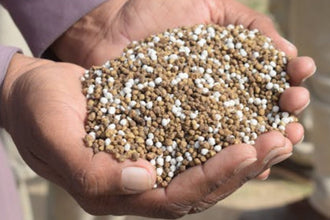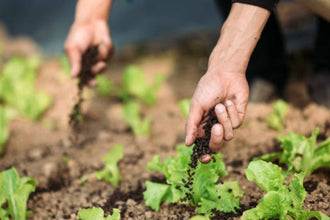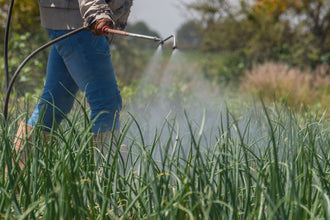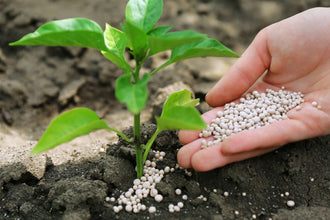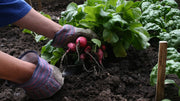
A complete fertilizer schedule makes all the difference between plants that just survive and gardens that actually thrive. Most people grab whatever fertilizer they see at the store and sprinkle it around whenever they remember. This random approach leaves plants hungry during the times they need food most.
Your plants don't need the same nutrients year-round. They go through growth spurts in spring, heavy production in summer, and prep time in fall. Each season calls for different feeding strategies. Getting this timing right means stronger plants, better harvests, and way less frustration in your garden.
The secret isn't just what you feed your plants. It's when you feed them. Plants are like athletes training for different events throughout the year. Feed them right and they'll perform at their peak.
How Plants Use Nutrients Throughout the Year
Plants follow pretty predictable patterns as seasons change. Understanding these patterns helps you time your fertilizer applications so nutrients are available exactly when plants need them most.
Spring kicks off with plants waking up from winter sleep. They're building new leaves and extending roots after months of dormancy. This takes a lot of energy and specific nutrients to fuel all that new growth.
Summer brings the main event. Most plants are flowering and producing fruits or vegetables. They need steady nutrition to keep up with this demanding production schedule. Miss this window and you'll see it in smaller harvests.
Fall means preparation time. Plants either get ready for winter dormancy or store energy for next year's growth. The nutrition focus shifts completely during this period.
Winter varies a lot depending on where you live. Cold areas see most plants go dormant while warmer zones keep some plants actively growing.
Spring Fertilizer Schedule
Spring feeding sets the tone for your entire growing season. Start too early and you risk pushing growth before the last frost. Wait too long and you miss the crucial early growth window.
The best approach is watching your plants rather than the calendar. Look for signs of new growth on perennials or get ready to feed when you plant your cool-season crops.
Early Spring Feeding Tips
Cool-season crops can handle some cold, so they get fed first. These include:
-
Lettuce and spinach
-
Peas and fava beans
-
Broccoli and cabbage
-
Onions and garlic
Start feeding these crops about 2-3 weeks before your last frost date. They actually grow better in cooler weather, so early feeding gives them a head start.
Mid-Spring Applications
Once soil temperatures hit 60°F consistently, it's time for warm-season plants. This includes most vegetables and annual flowers. Feed at planting time and then again 4-6 weeks later.
Container plants need more frequent feeding because nutrients wash out every time you water. Check these plants every 3-4 weeks during active growth.
Late Spring Preparation
Late spring feeding bridges the gap into summer. This application should carry your plants through the hot early summer months until their next feeding cycle.
Focus on balanced nutrition during this period. Plants are transitioning from pure growth mode into flower and fruit production.
Summer Fertilizer Schedule
Summer feeding keeps plants productive during their peak performance period. The challenge is providing nutrition without stressing plants during hot weather.
Early morning applications work best. Plants can absorb nutrients before the day heats up and stress levels rise. Never fertilize during the hottest part of the day.
Early Summer Focus
June feeding supports the transition from spring growth to summer production. Most plants are setting flowers and early fruits during this period.
This is when you see the biggest difference between well-fed and underfed gardens. Well-fed plants keep producing while stressed plants struggle through the heat.
Midsummer Maintenance
July and August feeding maintains production during peak heat stress. Many people skip summer feeding, but this period often makes or breaks your harvest totals.
Use lighter application rates during extreme heat. Plants can't process heavy nutrition when they're focusing on survival.
Late Summer Preparation
August feeding in most areas prepares plants for fall harvest crops while supporting continued production in heat-tolerant varieties.
Start reducing nitrogen levels slightly. You want to maintain production without encouraging soft growth that won't handle temperature swings.
Fall and Winter Care
Fall changes everything about how you approach fertilizer schedules. The goal shifts completely from promoting growth to preparing plants for dormancy and winter survival.
Fall Feeding Strategy
September through November requires a totally different mindset. You're no longer trying to push maximum growth. Instead, focus on plant health and preparation for the off-season.
Cool-season crops get a second chance during fall. These plants often perform better in fall than spring because they've had all summer to develop strong root systems.
Fall Application Timing
Early fall feeding supports late-season growth in cool-weather crops. At the same time, you're helping warm-season plants finish their production cycle strong.
Key changes for fall feeding:
-
Reduce nitrogen levels
-
Increase potassium for cold hardiness
-
Focus on root development
-
Support energy storage in perennials
Winter Considerations
Winter feeding depends entirely on your climate zone. Cold regions with frozen ground need zero winter fertilization. Warm areas continue modified feeding schedules.
Indoor plants and greenhouse growing continues year-round but at reduced rates. Most houseplants need about half their growing season nutrition during winter months.
Plant-Specific Schedules
Different types of plants need customized approaches. What works for vegetables might be completely wrong for flowers or fruit trees.
Vegetable Gardens
Cool-season vegetables like lettuce and peas want early spring feeding followed by light applications every 3-4 weeks. These crops usually finish before summer heat hits hard.
Warm-season vegetables including tomatoes and peppers need different timing. Feed at planting after soil warms, then every 4-6 weeks through their growing season.
Root vegetables like carrots and beets are tricky. Too much nitrogen makes huge tops but tiny, poorly-formed roots. These crops benefit more from good soil prep than heavy feeding.
Flower Gardens
Annual flowers need consistent feeding to bloom all season long. Monthly applications during active growth work well for most varieties.
Perennial flowers follow different rules based on when they bloom. Spring bloomers need fall feeding for next year's show. Summer bloomers want spring and early summer nutrition.
Bulbs have very specific needs tied to their growth cycles. Feed spring bulbs in fall when planted and again when foliage emerges. Summer bulbs get fed at planting and during growth.
Fruit Trees and Shrubs
Fruit trees need early spring feeding before bud break. This supports flower development and early fruit set. A second application in early summer helps fruit development.
Berry bushes vary by type. Strawberries need spring feeding and again after harvest. Blueberries want acidic fertilizers applied in early spring and midsummer.
Creating Your Personal Schedule
Every garden is different. Your fertilizer schedule needs to match your specific plants, soil, and climate conditions.
Start by identifying your local growing seasons. When does spring really arrive? How long is your summer? When do first and last frosts typically occur?
Soil testing gives you valuable baseline information. Test pH and nutrient levels annually to guide your fertilizer choices and application rates.
Keep records of what you do and how plants respond. Note application dates, fertilizer types, weather conditions, and plant performance. This information helps you refine your approach over time.
Watch your plants for signs they need schedule adjustments. Yellow leaves might mean too little nitrogen or too much water. Poor flower production often indicates feeding timing issues.
Common Problems and Solutions
Even good fertilizer schedules sometimes produce unexpected results. Learning to recognize and fix these problems keeps your garden on track.
Over-Fertilization Signs
Too much fertilizer shows up as excessive green growth with few flowers or fruits. Plants get lush and green but don't produce what you're growing them for.
Over-fed plants also tend to have more pest problems. Soft, nitrogen-rich growth attracts aphids and other insects.

Under-Fertilization Symptoms
Under-fed plants grow slowly and show pale, yellowish leaves. They struggle during stress periods and get sick more easily.
Poor production is another clear sign. Plants that should be loaded with vegetables or flowers but aren't usually need better nutrition.
Timing Issues
Wrong timing can waste fertilizer and harm plants. Late fall nitrogen applications encourage growth that won't survive winter cold.
Spring applications that come too early can push growth before plants are ready to handle cold snaps.
Why Fancy Chicken Organic Fertilizer Works Perfectly in Any Schedule
Fancy Chicken organic pelletized chicken manure fits seamlessly into any fertilizer schedule while delivering consistent, long-term results. This premium organic fertilizer eliminates the guesswork from timing applications since its slow-release formula feeds plants steadily over 4-6 weeks.
The Science Behind Slow-Release Nutrition
Traditional synthetic fertilizers dump nutrients into soil all at once, creating feast-or-famine conditions for your plants. Fancy Chicken's pelletized chicken manure breaks down gradually, releasing nutrients as soil microbes become active.
The 4-2.5-2 NPK ratio provides balanced nutrition that supports all growth phases. Nitrogen promotes healthy leaf development, phosphorus strengthens root systems and flower production, while potassium builds plant immunity and stress resistance.
This gradual release means you can't over-fertilize accidentally. Plants take what they need when they need it, reducing nutrient waste and preventing fertilizer burn.
Perfect Timing for Every Season
Fancy Chicken works exceptionally well for each season's unique demands:
Spring Applications:
-
Apply 2-3 weeks before last frost for cool-season crops
-
Feed warm-season plants at soil temperatures above 60°F
-
Single application lasts through early summer growth spurts
-
Builds soil microbial activity as temperatures warm
Summer Feeding:
-
Mid-season applications maintain steady production
-
Won't stress plants during heat waves like synthetic fertilizers
-
Continues feeding during hot weather when other fertilizers fail
-
Supports continuous harvest in vegetables and flowers
Fall Preparation:
-
Lower nitrogen levels naturally support winter hardiness
-
Feeds soil organisms that improve structure over winter
-
Builds nutrient reserves for next year's early growth
-
Supports root development in perennials and shrubs
Soil Building Benefits Beyond Basic Nutrition
Fancy Chicken doesn't just feed plants - it transforms your soil into a thriving ecosystem. Each application adds organic matter that improves soil structure and water retention.
The organic matter feeds beneficial microbes that break down nutrients and protect plant roots. These soil organisms create a natural defense system against harmful pathogens and pests.
Over time, regular applications reduce your need for other soil amendments. The improved soil holds nutrients longer and requires less frequent watering.
Application Made Simple
Using Fancy Chicken in your fertilizer schedule couldn't be easier. The pelletized form spreads evenly and won't blow away like powdered fertilizers.
Simply broadcast around plants and water in lightly. No special equipment needed, and you won't deal with dust or odors during application.
The consistent pellet size means even coverage every time. Mix into planting holes for new transplants or side-dress established plants during the growing season.
Get Your Garden Growing Strong
Your complete fertilizer schedule is the foundation for a productive, healthy garden that performs well all year long. Plants that get proper nutrition at the right times resist pests and diseases better while producing bigger harvests.
The key is starting simple and adjusting based on what you see in your own garden. Every location is a little different, so what works perfectly for your neighbor might need tweaks for your yard.
Ready to transform your garden with proper feeding schedules? Start by picking one section of your garden and implementing a complete fertilizer schedule this season. Track what happens and expand your approach as you see the results. Your plants will show you the difference good timing makes.




